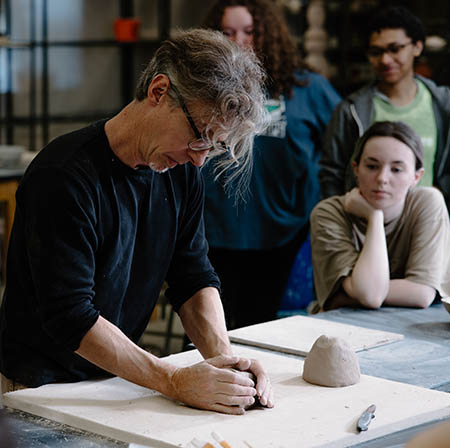Jax State Ceramics Professor John Oles Elected to the International Academy of Ceramics
11/06/2025
By Brett Buckner
 John Oles, Jacksonville State University associate professor of ceramics, is among the newest members of the International Academy of Ceramics (IAC). Nominated in June and officially elected in October, Oles joins 219 individual artists from 59 countries around the world in the prestigious academy.
John Oles, Jacksonville State University associate professor of ceramics, is among the newest members of the International Academy of Ceramics (IAC). Nominated in June and officially elected in October, Oles joins 219 individual artists from 59 countries around the world in the prestigious academy.
“I was honored to be invited and to be included in the company of some of my heroes and mentors,” Oles said. “The longer I work in this field and the more experienced I’ve become, the more comfortable I am participating in the dialogue of contemporary ceramics with artists I’ve always looked up to.”
The aim of the International Academy of Ceramics, which is based in Geneva, is to “promote friendship and communication between ceramics professionals in all countries,” according to the IAC website. “The IAC develops and encourages all forms of international cooperation to promote ceramics and to encourage and maintain production of the highest quality in all ceramic cultures.”
Since its founding in 1952, the IAC has steadily evolved. Originally, it had a strong diplomatic background, bringing together representatives of national museums and cultural organizations. Ceramists were invited as consultants. Currently, the IAC is the only association dedicated to the medium of clay that operates at an international level.
Personally, Oles is still getting used to the idea of officially being a member of such an esteemed group. The current IAC membership comprises over 1,200 members from 89 countries.
“This is one of those things that I usually see happening for other people but not me,” he said, “so, yes, in a sense it was very much a validation of a life’s work. Or at least it’s an honor to be given a seat at the table.”
Oles has been “quite fortunate” to participate in several international artist residency programs over the years, from Iceland to France to China. Many of these programs set aside a designated number of spots for IAC members, some of which are fully funded and include airfare. There are also international exhibition opportunities exclusively available to members.
“So, I really look forward to being an active participant in these and exhibiting work on the international level,” he said. “Looking back, any time that my artwork has gone through a major shift, it’s usually the result of the research and time spent at one of these international residences. Then, it takes about another three years in the studio to work everything out. “
As part of his election, Oles will be attending the New Member induction ceremony in Jingdezhen, China, next June. The IAC also hosts a Biennial Congress, an eight-day conference held in different parts of the world. Next year, it will be hosted by the Jingdezhen Ceramics University in Jingdezhen, China, where Oles recently visited as part of a six-week artist residency in June.
“I absolutely fell in love with the rich history and culture of China and the Chinese people while I was there,” Oles said, “I can’t wait to go back, especially now that I know my way around a bit better, and I have some friends there who I look forward to seeing again.”
Despite the career accolades and 10 years teaching ceramics at Jax State, as a young art student at UMass-Dartmouth, Oles wasn’t interested in working with clay. “Originally, I wanted to go to art school to study Illustration,” he said. “But, at that time, it was the major for all the jock artists in their white ballcaps and Dave Matthews Band t-shirts, who didn’t want to get dirty - remember, this was the 1990s. Being a bit of a fine art snob, I switched majors to painting.”
 Unfortunately, Oles was a “terrible painter,” so he quickly sought a different muse. Eventually, a ceramics graduate student whose work he respected taught a 3D Design class and took Oles over to the other campus, “at most schools, dirty stuff like ceramics, sculpture, and printmaking are always on the ‘Other’ campus,” he explained, and introduced him to those in the ceramics department.
Unfortunately, Oles was a “terrible painter,” so he quickly sought a different muse. Eventually, a ceramics graduate student whose work he respected taught a 3D Design class and took Oles over to the other campus, “at most schools, dirty stuff like ceramics, sculpture, and printmaking are always on the ‘Other’ campus,” he explained, and introduced him to those in the ceramics department.
“I was really excited by the energy and community of the people in the program,” Oles said, “as well as the diversity of work being made, from functional pots to abstract sculptures and multimedia installations.”
Oles switched his major to ceramics. As soon as he fired his first wood kiln, he was hooked. His professor, Chris Gustin, taught a kiln-building class in which he built a Japanese-style anagama kiln on his property in South Dartmouth, MA. This type of kiln is fueled entirely with wood, and it takes a team of people constantly stoking the firebox 24 hours a day for four or five days to reach the desired temperature of 2,400 degrees.
Oles remembers an overnight shift working the firebox with a couple of grad students. Around 4 a.m. in the depths of sleep deprivation, just as the sky began to lighten with the coyotes howling in the distance, somebody put on Will the Circle Be Unbroken by the Nitty Gritty Dirt Band and passed around a flask of bourbon.
“It was at that exact moment I knew, somehow, I was going to do this for the rest of my life,” he said. “Needless to say, my parents were not pleased.”

